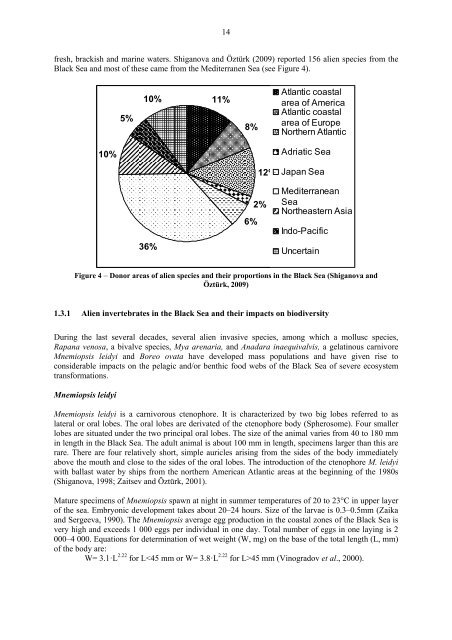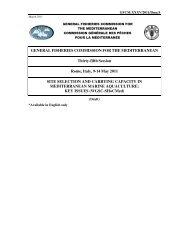Status of alien species in the Mediterranean and Black Sea
Status of alien species in the Mediterranean and Black Sea
Status of alien species in the Mediterranean and Black Sea
Create successful ePaper yourself
Turn your PDF publications into a flip-book with our unique Google optimized e-Paper software.
14<br />
fresh, brackish <strong>and</strong> mar<strong>in</strong>e waters. Shiganova <strong>and</strong> Öztürk (2009) reported 156 <strong>alien</strong> <strong>species</strong> from <strong>the</strong><br />
<strong>Black</strong> <strong>Sea</strong> <strong>and</strong> most <strong>of</strong> <strong>the</strong>se came from <strong>the</strong> Mediterranen <strong>Sea</strong> (see Figure 4).<br />
10%<br />
Figure 4 – Donor areas <strong>of</strong> <strong>alien</strong> <strong>species</strong> <strong>and</strong> <strong>the</strong>ir proportions <strong>in</strong> <strong>the</strong> <strong>Black</strong> <strong>Sea</strong> (Shiganova <strong>and</strong><br />
Öztürk, 2009)<br />
1.3.1 Alien <strong>in</strong>vertebrates <strong>in</strong> <strong>the</strong> <strong>Black</strong> <strong>Sea</strong> <strong>and</strong> <strong>the</strong>ir impacts on biodiversity<br />
Dur<strong>in</strong>g <strong>the</strong> last several decades, several <strong>alien</strong> <strong>in</strong>vasive <strong>species</strong>, among which a mollusc <strong>species</strong>,<br />
Rapana venosa, a bivalve <strong>species</strong>, Mya arenaria, <strong>and</strong> Anadara <strong>in</strong>aequivalvis, a gelat<strong>in</strong>ous carnivore<br />
Mnemiopsis leidyi <strong>and</strong> Boreo ovata have developed mass populations <strong>and</strong> have given rise to<br />
considerable impacts on <strong>the</strong> pelagic <strong>and</strong>/or benthic food webs <strong>of</strong> <strong>the</strong> <strong>Black</strong> <strong>Sea</strong> <strong>of</strong> severe ecosystem<br />
transformations.<br />
Mnemiopsis leidyi<br />
5%<br />
10%<br />
36%<br />
11%<br />
Mnemiopsis leidyi is a carnivorous ctenophore. It is characterized by two big lobes referred to as<br />
lateral or oral lobes. The oral lobes are derivated <strong>of</strong> <strong>the</strong> ctenophore body (Spherosome). Four smaller<br />
lobes are situated under <strong>the</strong> two pr<strong>in</strong>cipal oral lobes. The size <strong>of</strong> <strong>the</strong> animal varies from 40 to 180 mm<br />
<strong>in</strong> length <strong>in</strong> <strong>the</strong> <strong>Black</strong> <strong>Sea</strong>. The adult animal is about 100 mm <strong>in</strong> length, specimens larger than this are<br />
rare. There are four relatively short, simple auricles aris<strong>in</strong>g from <strong>the</strong> sides <strong>of</strong> <strong>the</strong> body immediately<br />
above <strong>the</strong> mouth <strong>and</strong> close to <strong>the</strong> sides <strong>of</strong> <strong>the</strong> oral lobes. The <strong>in</strong>troduction <strong>of</strong> <strong>the</strong> ctenophore M. leidyi<br />
with ballast water by ships from <strong>the</strong> nor<strong>the</strong>rn American Atlantic areas at <strong>the</strong> beg<strong>in</strong>n<strong>in</strong>g <strong>of</strong> <strong>the</strong> 1980s<br />
(Shiganova, 1998; Zaitsev <strong>and</strong> Öztürk, 2001).<br />
Mature specimens <strong>of</strong> Mnemiopsis spawn at night <strong>in</strong> summer temperatures <strong>of</strong> 20 to 23°C <strong>in</strong> upper layer<br />
<strong>of</strong> <strong>the</strong> sea. Embryonic development takes about 20–24 hours. Size <strong>of</strong> <strong>the</strong> larvae is 0.3–0.5mm (Zaika<br />
<strong>and</strong> Sergeeva, 1990). The Mnemiopsis average egg production <strong>in</strong> <strong>the</strong> coastal zones <strong>of</strong> <strong>the</strong> <strong>Black</strong> <strong>Sea</strong> is<br />
very high <strong>and</strong> exceeds 1 000 eggs per <strong>in</strong>dividual <strong>in</strong> one day. Total number <strong>of</strong> eggs <strong>in</strong> one lay<strong>in</strong>g is 2<br />
000–4 000. Equations for determ<strong>in</strong>ation <strong>of</strong> wet weight (W, mg) on <strong>the</strong> base <strong>of</strong> <strong>the</strong> total length (L, mm)<br />
<strong>of</strong> <strong>the</strong> body are:<br />
W= 3.1·L 2.22 for L45 mm (V<strong>in</strong>ogradov et al., 2000).<br />
8%<br />
6%<br />
12%<br />
2%<br />
Atlantic coastal<br />
area <strong>of</strong> America<br />
Atlantic coastal<br />
area <strong>of</strong> Europe<br />
Nor<strong>the</strong>rn Atlantic<br />
Adriatic <strong>Sea</strong><br />
Japan <strong>Sea</strong><br />
<strong>Mediterranean</strong><br />
<strong>Sea</strong><br />
Nor<strong>the</strong>astern Asia<br />
Indo-Pacific<br />
Uncerta<strong>in</strong>
















